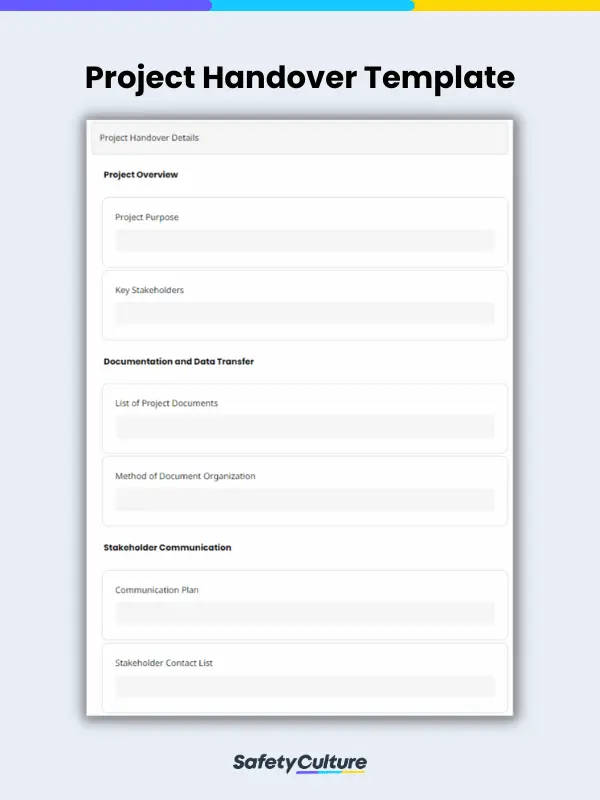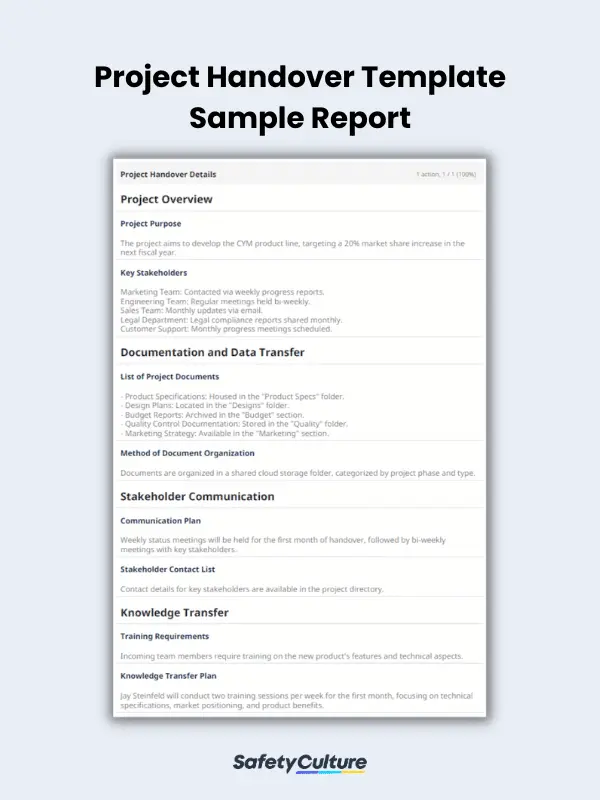What is a Project Handover Template?
A project handover template is a structured tool or list of tasks and responsibilities that outlines the steps and actions required to transition a project from one team or phase to another. It serves as a guide for project managers and stakeholders to ensure that the project is transferred smoothly, its objectives are met during and after the transition, all necessary information is shared, and the new team or responsible party is well-prepared to take over and continue the project.
Importance of Using One
Using templates for every aspect of project management, such as during project handovers, can help make the overall process of executing and closing the project more efficient in the following ways:
Standardization and Consistency
Using a project handover template ensures that each handover follows a structured process, reducing the risk of critical steps being missed or overlooked. This is especially crucial when multiple projects or teams are involved, as it streamlines the handover process across the organization.
Clarity and Accountability
By providing a clear and predefined set of tasks and responsibilities, a handover template enhances clarity among team members and stakeholders. This is because it leaves no room for ambiguity regarding who’s responsible for what during the transition. Hence, this fosters accountability, ensuring that individuals and teams fulfill their roles effectively.
Efficient Knowledge Transfer
One of the primary benefits of a project handover template is that it outlines the specific knowledge and information that needs to be transferred from the outgoing team to the incoming team. This ensures that critical project knowledge, including best practices, lessons learned, and technical details, is effectively passed on.
Time and Resource Savings
Using a template significantly reduces the time and effort required to create a handover plan from scratch for each project. Project managers can then focus their energy on project-specific details rather than reinventing the process, leading to time and resource savings. Also, this efficiency allows teams to allocate resources more effectively and accelerate the handover process.
Enhanced Collaboration
Project handover templates help promote open communication by providing a shared framework for discussions and decisions. This collaborative environment encourages team members to share insights, address challenges, and work together to ensure a successful handover.
What to Include in a Project Handover Template
Undeniably, a project handover template is an invaluable tool in project management that must be comprehensive and cover all essential aspects of the handover process to ensure a smooth transition.
Generally, it must include the following elements and sections:
- Project Overview – purpose and key stakeholders
- Documentation and Data Transfer – list of project-related documents and method of document organization
- Stakeholder Communication – communication plan and contact list
- Knowledge Transfer – training requirements and knowledge transfer plan
- Roles and Responsibilities – employee names, teams, and roles
- Project Status and Progress – timelines, deadlines, key milestones, outstanding issues, and follow-up schedules
- Technical Information – specifications, access to tools and systems, and legal and compliance requirements
- Quality Control (QC) and Testing – Quality Assurance (QA) measures and compliance with standards
- Dependencies and External Relationships – list of dependencies and dependency management strategies
5 Key Steps to Creating a Template for Project Handovers
Creating a well-structured project handover template is crucial to ensuring a successful transition and maintaining project continuity. Follow this straightforward guide to help you make one that can be effective in your organization:
1. Define template objectives.
Clearly outline the objectives of your handover template. Determine its primary purpose, whether it’s to standardize processes, enhance knowledge transfer, or ensure compliance with regulations.
2. Identify key sections.
Identify the critical sections and components your template should include. These may encompass documentation transfer, communication plans, roles and responsibilities, dependencies, and legal considerations. Make sure to tailor these sections to your project’s specific needs.
3. Use proper structure and formatting.
Design a clear and intuitive flow for your template. Create logical sections with headings and subheadings to organize information and employ consistent formatting for easy readability and navigation.
4. Create task lists.
Within each section, provide task lists that are required for a successful handover. Include deadlines or timelines to ensure accountability and progress tracking.
5. Incorporate feedback.
Make sure to include a feedback mechanism in the template to encourage stakeholders and team members to provide input and suggest improvements. This way, you can revisit and revise the template based on feedback and changing project needs for continuous enhancement.
How to Improve Project Handovers Using a Template
To help organizations continuously improve how project handovers are conducted, they can use templates as a practical and effective way to seamlessly document and manage all tasks and processes.
Take these steps to efficiently use a project handover template:
1. Establish a standardized process.
Create a standardized process for project handovers using your template. This should encompass documentation transfer, communication plans, training requirements, and clearly defined roles. This helps reduce confusion and ensure that critical steps are consistently followed.
2. Enhance communication.
Effective communication is essential for transferring knowledge and resolving issues promptly. For this, use the template to specify communication plans between outgoing and incoming teams. Also, clearly outline meeting schedules and preferred communication channels.
3. Ensure accountability.
Make sure to specify and clearly define who’s responsible for each aspect of the handover. This promotes accountability and prevents important tasks from being overlooked.
4. Capture knowledge and best practices.
Utilize the template to document project-specific knowledge and best practices. Don’t forget to include sections for technical details, lessons learned, and critical information that should be transferred to the incoming team for seamless project continuity.
To give you an example, here’s what a filled-out template looks like as a project handover report:
FAQs About Project Handover Templates
Project handover templates are versatile, can be used in various industries, and are applicable to different types of projects. These include construction, manufacturing, and service-based projects. Also, these templates are adaptable to suit unique project needs.
While both play essential roles in the project management process, they have distinct purposes and are used at different stages of a project. A project handover template facilitates the transition of project ownership or responsibility during the project’s lifecycle, whereas the project closure checklist focuses on formally closing out the project after its objectives have been achieved or abandoned.
A project handover template plays a significant role in quality assurance by outlining quality control processes, testing procedures, and quality assurance measures, among others. It helps ensure that quality standards are maintained during the handover process.




